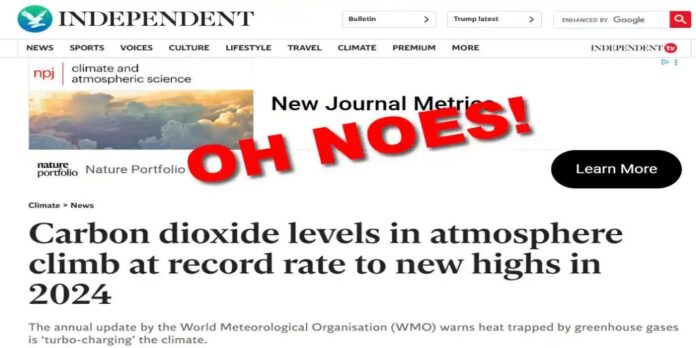The Independent’s recent piece, “Carbon dioxide levels in atmosphere climb at record rate to new highs in 2024”, is another fine example of what happens when journalists mistake short-term statistical noise for a planetary emergency. The article leans heavily on the World Meteorological Organization’s (WMO) annual bulletin, which reported a 3.5 parts per million (ppm) increase in atmospheric CO₂ from 2023 to 2024 — described breathlessly as the “largest increase since modern measurements began in 1957.”
But here’s the thing: when you actually look at the data — not the headlines — this “record” increase is barely a blip in the context of natural variability. In other words, it’s a minor uptick well within the statistical standard deviations of the long-term trend. The so-called “record” rise doesn’t signal anything alarming, except perhaps the media’s inability to resist turning every decimal point into a doomsday prophecy.
SPOT THE RECORD RATE OF RISE:

Atmospheric CO₂ levels have indeed been increasing — that’s not under dispute. But the rate of increase fluctuates year to year, depending on natural factors such as El Niño, volcanic activity, oceanic uptake, and vegetation growth cycles.
The Independent article itself admits this, though buried halfway down the text:
“The record increase in carbon dioxide in the atmosphere in 2024 is likely due to a large contribution from wildfire emissions and reduced uptake by land and ocean ‘carbon sinks’ as the world faced its hottest year on record, with a strong El Niño weather pattern.”
In other words, natural processes — not industrial emissions — were the dominant factor behind the temporary bump.
We’ve seen this before. The El Niño of 1997–98 and again in 2015–16 produced similarly sharp, temporary increases in CO₂ growth rates. Those weren’t evidence of an out-of-control climate spiral then, and they aren’t now. Once those events subsided, the rate of increase returned to its mean.
The WMO’s reported “record” increase of 3.5 ppm sounds dramatic — until you remember that CO₂ levels have risen by roughly 2.3 ppm per year on average since 2010. A 1.2 ppm deviation over one year is statistically insignificant, especially when the Mauna Loa record has year-to-year variability ranging from 1 to 3 ppm depending on global conditions.
If we chart this in context, the 2024 “spike” sits comfortably within the historical standard deviation band of the dataset. Nothing about it suggests an accelerating “runaway” effect. To call it “record-breaking” is akin to celebrating a thermometer reading that’s one degree above last week’s high — technically true, but scientifically trivial.
WMO deputy secretary-general Ko Barrett told The Independent:
“The heat trapped by CO₂ and other greenhouse gases is turbo-charging our climate and leading to more extreme weather.”
This sort of language is designed to grab headlines, not convey nuance. It conflates energy balance physics — which are real but steady — with weather extremes, which remain highly variable and poorly correlated with incremental CO₂ changes on an annual basis. No physical mechanism supports the idea that a 3.5 ppm rise in atmospheric CO₂ suddenly “turbo-charged” anything. That’s a sound bite, not science. Natural variability is not “Turbo-Charging”
El Niño: The Real Driver
The 2023–2024 El Niño was strong, marked by significant warming of the Pacific and widespread drought and wildfires — exactly the kind of natural feedback that temporarily boosts atmospheric CO₂. During El Niño years, tropical forests dry out, microbial respiration increases, and ocean outgassing spikes. When the pattern flips to La Niña, those processes reverse and CO₂ uptake increases again.
This natural oscillation can add or subtract roughly 1 ppm per year from the growth rate. The 3.5 ppm figure therefore sits perfectly within what the historical record predicts for a major El Niño phase. Blaming human emissions alone, as the Independent does, ignores half the equation.
The article warns ominously of a “vicious climate cycle” where warming reduces the ability of oceans and land to absorb CO₂. Yet long-term datasets show no measurable decline in the global carbon sink efficiency. Oceanic uptake continues to account for about 25% of emissions, while land biosphere absorption accounts for another 30%, remarkably stable over decades.
If anything, the biosphere has been greening — NASA satellite data show increasing vegetation coverage over the past 30 years, driven in part by CO₂ fertilization. That’s an inconvenient fact for the “vicious cycle” narrative.
Every few years, a natural fluctuation in CO₂ growth becomes the latest “record” for journalists to hype. Then it fades into the background as the cycle reverses. We saw the same media handwringing in 2016, when global CO₂ rose by 3.3 ppm during another strong El Niño. A year later, the increase dropped back to 1.9 ppm, and nobody reported a “record low.” Funny how that works.
This pattern of selective attention — celebrating peaks and ignoring troughs — is what drives public misperception. Real science tracks trends, not headlines.
Conclusion: A Molehill in a Mountain Range
The 2024 CO₂ increase is entirely within expected natural variation. There’s no sign of a “turbo-charged climate” or collapsing carbon sinks. What we do see, however, is the media’s unbroken commitment to amplifying every wiggle in the graph into a “record-breaking” emergency.
CO₂’s rise continues steadily, yes — but with no evidence that the Earth’s system is responding in a way that justifies alarm. As always, context matters. And when that context is ignored, what’s left isn’t science — it’s storytelling. The Independent’s “record rate” is a statistical blip dressed up as climate catastrophe. A little skepticism — and a glance at the Mauna Loa dataset — reveals a very different picture: the planet’s carbon cycle behaving exactly as it has for decades.
Related
Discover more from Watts Up With That?
Subscribe to get the latest posts sent to your email.



